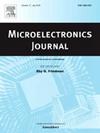Performance analysis of dual stacked DRAM for low power embedded devices
IF 1.9
3区 工程技术
Q3 ENGINEERING, ELECTRICAL & ELECTRONIC
引用次数: 0
Abstract
This work presents a novel dual-stacked silicon/SiGe-based DRAM architecture intended to overcome the constraints of conventional DRAM like scaling, high refresh power and charge leakage. Two vertically stacked layers of silicon and silicon-germanium (SiGe) with 40 % Ge content have been used in the proposed structure to maximize band-to-band tunnelling (BTBT) that has resulted in improved charge storage and retention without the necessity of a large capacitor. Channel engineering of SiGe area in the proposed structure has considerably enhanced the tunnelling rate that has resulted in faster and more effective write and hold operations. Enhanced read reliability is confirmed by a notable sense margin of 6.61 × 10-6 A/μm and retention time of approximately 500 ms. The proposed small, capacitorless and energy-efficient DRAM design has successfully demonstrated all the basic DRAM operations like Write '1′, Hold '1′, Read '1′ to verify logic high and then Write '0′, Hold '0′, Read '0′ to confirm logic low, for next generation low power embedded applications.
低功耗嵌入式器件双堆叠DRAM性能分析
这项工作提出了一种新颖的双堆叠硅/硅基DRAM架构,旨在克服传统DRAM的限制,如缩放,高刷新功率和电荷泄漏。两层垂直堆叠的硅和硅锗(SiGe),其锗含量为40%,已被用于该结构中,以最大限度地提高带对带隧道效应(BTBT),从而改善电荷存储和保持,而无需大型电容器。拟议结构中SiGe区域的通道工程大大提高了隧道掘进速度,从而实现了更快、更有效的写入和保持操作。显著的传感裕度为6.61 × 10-6 a /μm,保持时间约为500 ms,从而提高了读取可靠性。提出的小型,无电容和节能的DRAM设计已经成功地演示了所有基本的DRAM操作,如写‘1 ’,保持‘1 ’,读‘1 ’来验证逻辑高,然后写‘0 ’,保持‘0 ’,读‘0 ’来确认逻辑低,用于下一代低功耗嵌入式应用。
本文章由计算机程序翻译,如有差异,请以英文原文为准。
求助全文
约1分钟内获得全文
求助全文
来源期刊

Microelectronics Journal
工程技术-工程:电子与电气
CiteScore
4.00
自引率
27.30%
发文量
222
审稿时长
43 days
期刊介绍:
Published since 1969, the Microelectronics Journal is an international forum for the dissemination of research and applications of microelectronic systems, circuits, and emerging technologies. Papers published in the Microelectronics Journal have undergone peer review to ensure originality, relevance, and timeliness. The journal thus provides a worldwide, regular, and comprehensive update on microelectronic circuits and systems.
The Microelectronics Journal invites papers describing significant research and applications in all of the areas listed below. Comprehensive review/survey papers covering recent developments will also be considered. The Microelectronics Journal covers circuits and systems. This topic includes but is not limited to: Analog, digital, mixed, and RF circuits and related design methodologies; Logic, architectural, and system level synthesis; Testing, design for testability, built-in self-test; Area, power, and thermal analysis and design; Mixed-domain simulation and design; Embedded systems; Non-von Neumann computing and related technologies and circuits; Design and test of high complexity systems integration; SoC, NoC, SIP, and NIP design and test; 3-D integration design and analysis; Emerging device technologies and circuits, such as FinFETs, SETs, spintronics, SFQ, MTJ, etc.
Application aspects such as signal and image processing including circuits for cryptography, sensors, and actuators including sensor networks, reliability and quality issues, and economic models are also welcome.
 求助内容:
求助内容: 应助结果提醒方式:
应助结果提醒方式:


